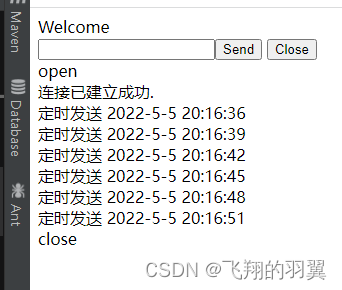1、依赖:
<!-- websocket 依赖 -->
<dependency>
<groupId>org.springframework.boot</groupId>
<artifactId>spring-boot-starter-websocket</artifactId>
</dependency>2.加配置
新建一个Java配置类,注入ServerEndpointExporter 配置,如果是使用springboot内置的tomcat此配置必须,如果是使用的是外部tomcat容器此步骤请忽略:
@Configuration
public class WebSocketConfig {
@Bean
public ServerEndpointExporter serverEndpointExporter() {
return new ServerEndpointExporter();
}
}
3.新建API实现类
@ServerEndpoint(value = "/wsdemo") 前端通过此URI 和后端交互,建立连接
@Component 不用说将此类交给spring管理
@OnOpen websocket建立连接的注解,前端触发上面URI时会进入此注解标注的方法,和之前关于DWR文章中的onpage方法类似
@OnClose 顾名思义关闭连接,销毁session
@OnMessage 收到前端传来的消息后执行的方法
@ServerEndpoint(value = "/wsdemo")
@Component
public class MyWebSocket {
/**静态变量,用来记录当前在线连接数。应该把它设计成线程安全的。*/
private static int onlineCount = 0;
/** concurrent包的线程安全Set,用来存放每个客户端对应的MyWebSocket对象。
在外部可以获取此连接的所有websocket对象,并能对其触发消息发送功能,我们的定时发送核心功能的实现在与此变量 */
private static CopyOnWriteArraySet<MyWebSocket> webSocketSet = new CopyOnWriteArraySet<MyWebSocket>();
/**与某个客户端的连接会话,需要通过它来给客户端发送数据*/
private Session session;
/**
* 连接建立成功调用的方法
*
* 类似dwr的onpage方法,参考之前文章中demo有
* */
@OnOpen
public void onOpen(Session session) {
this.session = session;
webSocketSet.add(this); //加入set中
addOnlineCount(); //在线数加1
System.out.println("有新连接加入!当前在线人数为" + getOnlineCount());
try {
sendMessage("连接已建立成功.");
} catch (Exception e) {
System.out.println("IO异常");
}
}
/**
* 连接关闭调用的方法
*
* 参考dwrsession摧毁方法
*/
@OnClose
public void onClose() {
webSocketSet.remove(this); //连接关闭后,将此websocket从set中删除
subOnlineCount(); //在线数减1
System.out.println("有一连接关闭!当前在线人数为" + getOnlineCount());
}
/**
* 收到客户端消息后调用的方法
*
* @param message 客户端发送过来的消息*/
@OnMessage
public void onMessage(String message, Session session) {
System.out.println("来自客户端的消息:" + message);
}
// 错误提示
@OnError
public void onError(Session session, Throwable error) {
System.out.println("发生错误");
error.printStackTrace();
}
// 发送消息,在定时任务中会调用此方法
public void sendMessage(String message) throws IOException {
this.session.getBasicRemote().sendText(message);
}
public static synchronized int getOnlineCount() {
return onlineCount;
}
public static synchronized void addOnlineCount() {
MyWebSocket.onlineCount++;
}
public static synchronized void subOnlineCount() {
MyWebSocket.onlineCount--;
}
public Session getSession() {
return session;
}
public void setSession(Session session) {
this.session = session;
}
public static CopyOnWriteArraySet<MyWebSocket> getWebSocketSet() {
return webSocketSet;
}
public static void setWebSocketSet(CopyOnWriteArraySet<MyWebSocket> webSocketSet) {
MyWebSocket.webSocketSet = webSocketSet;
}
}4.使用spring的Schedule建立定时任务
@EnableScheduling 开启spring定时任务功能
@Scheduled(cron = "0/3 * * * * ?") 用于标识定时执行的方法,此处主要方法返回值一定是void,没有入参。对应定时时间配置可以百度cron语法,根据自己的业务选择合适的周期
在这类中,我们通过上面MyWebSocket提供的静态方法获取其中的webSocketSet ,来获取所有此业务相关的所有websocketsession,可以在定时任务中对session内容进行验证判断(权限验证等),进行发送消息
@Component
@EnableScheduling
public class TimeTask
{
private static Logger logger = LoggerFactory.getLogger(TimeTask.class);
@Scheduled(cron = "0/3 * * * * ?") //3秒钟执行一次
public void test(){
System.err.println("********* 定时任务执行 **************");
CopyOnWriteArraySet<MyWebSocket> webSocketSet =
MyWebSocket.getWebSocketSet();
int i = 0 ;
webSocketSet.forEach(c->{
try {
c.sendMessage(" 定时发送 " + new Date().toLocaleString());
} catch (IOException e) {
e.printStackTrace();
}
});
System.err.println("/n 定时任务完成.......");
}
}5.新建一个测试页面作为静态资源:(端口换成本地项目端口)
<!DOCTYPE HTML>
<html>
<head>
<title>My WebSocket</title>
</head>
<body>
Welcome<br/>
<input id="text" type="text" /><button onclick="send()">Send</button> <button onclick="closeWebSocket()">Close</button>
<div id="message">
</div>
</body>
<script type="text/javascript">
var websocket = null;
//判断当前浏览器是否支持WebSocket ,主要此处要更换为自己的地址
if('WebSocket' in window){
websocket = new WebSocket("ws://localhost:8886/wsdemo");
}
else{
alert('Not support websocket')
}
//连接发生错误的回调方法
websocket.onerror = function(){
setMessageInnerHTML("error");
};
//连接成功建立的回调方法
websocket.onopen = function(event){
setMessageInnerHTML("open");
}
//接收到消息的回调方法
websocket.onmessage = function(event){
setMessageInnerHTML(event.data);
}
//连接关闭的回调方法
websocket.onclose = function(){
setMessageInnerHTML("close");
}
//监听窗口关闭事件,当窗口关闭时,主动去关闭websocket连接,防止连接还没断开就关闭窗口,server端会抛异常。
window.onbeforeunload = function(){
websocket.close();
}
//将消息显示在网页上
function setMessageInnerHTML(innerHTML){
document.getElementById('message').innerHTML += innerHTML + '<br/>';
}
//关闭连接
function closeWebSocket(){
websocket.close();
}
//发送消息
function send(){
var message = document.getElementById('text').value;
websocket.send(message);
}
</script>
</html>6.演示效果:























 167
167











 被折叠的 条评论
为什么被折叠?
被折叠的 条评论
为什么被折叠?








